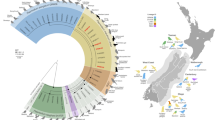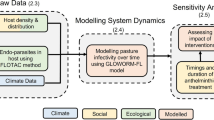Abstract
Vervet monkeys (Chlorocebus pygerythrus) are non-human primates belonging to the family Cercopithecidae, which are native to Africa. The objective of the present study was to assess the occurrence of gastrointestinal parasites in free-ranging vervet monkeys. A total of 140 free-ranging vervet monkeys found in the recreational areas of Hawassa city, Ethiopia, were examined for gastrointestinal parasitic infection from November 2013 to April 2014. For the identification of eggs and larvae of nematodes and cysts, oocysts and trophozoites of protozoa, faecal samples were subjected to direct smear and floatation techniques. Overall, out of 140 faecal samples examined, 75 % were found to harbour one or more gastrointestinal nematode parasites. The most frequently detected nematode parasite was hookworms (45.7 %). Parasite eggs suggestive of cestode parasites were found in 7.9 % of the samples. Coccidia were the most commonly detected protozoa parasites (27.1 %). Mixed infections with two or more parasites were detected in 74.3 % of the examined faecal samples. The present study can give baseline information on the occurrence of parasitic infection in wild vervet monkeys in the area. Future studies in the area should focus not only on the animals but also on the determination of the possible transmission of the parasites to humans which do have close interaction with the vervet monkeys.

Similar content being viewed by others
References
Borgsteede FHM (1996) The effect of parasites on wildlife. Vet Q 18(sup3):138–140
Brack M (1987) Agents transmissible from simians to man. Springer, London
Chapman CA, Speirs ML, Gillespie TR, Holland T, Austad KM (2006) Life on the edge: gastrointestinal parasites from the forest edge and interior primate groups. Am J Primatol 68(4):397–409
Cox FEG (2001) Concomitant infections, parasites and immune responses. Parasitology 122(S1):23–38
Dupain J, van Elsacker L, Nell C, Garcia P, Ponce F, Huffman MA (2002) New evidence for leaf swallowing and Oesophagostomum infection in bonobos (Pan paniscus). Int J Primatol 23:1053–1062
Gillespie TR, Chapman CA, Greiner EC (2005) Effects of logging on gastrointestinal parasite infections and infection risk in African primates. J Appl Ecol 42:699–707
Hendrix CM (1998) Diagnostic veterinary parasitology, 2nd edn. Mosby Inc, USA
Huffman MA, Gotohl S, Turnerm Hamai M, Yoshida K (1997) Seasonal trends in intestinal nematode infection and medicinal plant use among chimpanzees in the Mahale Mountains, Tanzania. Primates 38:111–125
Isbell LA, Pruetz JD, Young TP (1998) Movements of vervets (Cercopithecus aethiops) and patas monkeys (Erythrocebus patas) as estimators of food resource size, density, and distribution. Behav Ecol Sociobiol 42:123–133
Jolles AE, Ezenwa VO, Etienne RS, Turner WC, Olff H (2008) Interactions between macroparasites and microparasites drive infection patterns in free-ranging African buffalo. Ecology 89(8):2239–2250
Kingdon J, Gippoliti S, Butynski TM, De Jong Y (2008). Chlorocebus pygerythrus. The IUCN Red List of Threatened Species. Version 2014.3.www.iucnredlist.org. Downloaded on 28 February 2015
Legesse M, Erko B (2004) Zoonotic intestinal parasites in Papio anubis (baboon) and Cercopithecus aethiops (vervet) from four localities in Ethiopia. Acta Trop 90:231–236
MAFF (Ministry of Agriculture, Fisheries and Food) (1977) Manual of veterinary parasitological laboratory techniques. Tech. Bull. No., 18: Her majesty’s Stationery office, London, 1–40
Muriuki SMK, Murugu RK, Munene E, Karere GM, Chai DC (1998) Some gastro-intestinal parasites of zoonotic (public health) importance commonly observed in old world non-human primates in Kenya. Acta Trop 7(1):73–82
Petrášová J, Modrý D, Huffman MA, Mapua MI, Bobáková L, Mazoch V, Singh J, Kaur T, Petrželková KJ (2010) Gastrointestinal parasites of indigenous and introduced primate species of Rubondo Island National Park, Tanzania. Am J Primatol 31(5):920–936
Shimada MK, Shotake T (1997) Genetic variation of blood proteins within and between local populations of grivet monkey in central Ethiopia. Primates 38:399–414
Verweij JJ, Vermeer J, Brienen EAT, Blotkamp C, Laeijendecker D, Van Lieshout L, Polderman AM (2003) Entamoeba histolytica infections in captive primates. Parasitol Res 90:100–103
Woolhouse ME, Thumbi SM, Jennings A, Chase-Topping M, Callaby R, Kiara H, Oosthuizen MC, Mbole-Kariuki MN, Conradie I, Handel IG, Poole EJ, Njiiri E, Collins NE, Murray G, Tapio M, Auguet OT, Weir W, Morrison WI, Kruuk LEB, Bronsvoort BMC, Hanotte O, Coetzer K, Toye PG (2015) Co-infections determine patterns of mortality in a population exposed to parasite infection. Science Advances 1(2):e1400026
Zajac AM, Conboy GA (eds) (2012) Veterinary clinical parasitology. John Wiley & Sons
Acknowledgements
Hawassa University is duly acknowledged for the provision the fund to execute the present study. The authors would like to thank also the people around Lake Hawassa for their cooperation in assisting faecal collection from the vervet monkeys.
Author information
Authors and Affiliations
Corresponding author
Rights and permissions
About this article
Cite this article
Amenu, K., Tesfaye, D., Tilahun, G. et al. Gastrointestinal parasites of vervet monkeys around Lake Hawassa recreational sites, southern Ethiopia. Comp Clin Pathol 24, 1491–1496 (2015). https://doi.org/10.1007/s00580-015-2105-0
Received:
Accepted:
Published:
Issue Date:
DOI: https://doi.org/10.1007/s00580-015-2105-0




